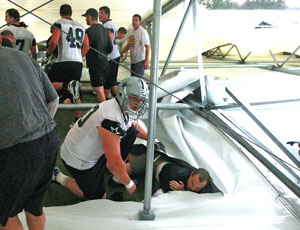Following its sudden collapse May 2 of a fabric-covered indoor practice facility, neither the Dallas Cowboys nor the company that designed and supplied the structure are talking about the design or the engineering of the membrane-covered structure. With lawsuits likely to follow an event that resulted in three serious injuries, the National Football League team and Summit Structures are deferring detailed questions until an Occupational Safety and Health Administration investigation is complete. OSHA routinely takes up to six months to complete accident investigations.

As rookie football players practiced indoors in Irving, Texas, during a swiftly moving thunderstorm, the fabric-clad building began to tremble. Suspended light fixtures began to sway. Within seconds, the entire structure collapsed. Twelve of the 70 people freed from the steel and fabric rubble were taken to the hospital. Three sustained serious injuries.
Summit Structures of Allentown, Pa., manufactured the 80-ft tall pre-engineered, steel-framed, fabric-covered membrane building at its Cover-All Building Systems manufacturing plant in Saskatoon, Canada. Summit installed the structure, which is larger than a football field, in 2003, according to a prepared statement issued by the company.
“The engineering, and related approvals for the facility were managed by professional engineers licensed to practice engineering in Texas, both in 2003 and again in 2008 when the building was upgraded and a new roof covering was installed on the facility,” said Nathan Stobbe, president of Summit Structures in the written statement.
“We understand there is a great deal of concern and curiosity about what happened on Saturday, but rather than speculate, we are focused on being part of the effort to find answers and assist the team,” Stobbe said in the statement.
Summit Structures spokesperson Mariellen Burns would not release the name of the engineers involved with the Cowboys’ dome. She said in response to a question about what specs the building was designed to withstand, “as is the industry standard, Summit Structures designs, engineers, and builds to meet local building codes.”
The Occupational Safety and Health Administration is investigating, says agency spokesperson Elizabeth Todd.
The National Weather Service determined, based on a survey of the damage, radar imagery and eyewitness reports, that a microburst hit the Valley Ranch area far north of Irving, Texas, according to a release provided by Summit Structures. The agency pegged the maximum winds near the ground at 70 mph at the time of the collapse, which was 3:27 p.m. (CDT). However, NWS states that winds could have been stronger higher off the ground.
While Summit initially installed the dome, The Dallas Morning News reported on May 5, 2009, that the Dallas Cowboys applied for the building permit to replace the fabric roof, registering as a general contractor on the same day. The team did not notify the city that the work was complete, nor was an inspection performed, according to reports.
Cowboys spokesperson Rich Dalrymple says the team is not commenting on anything relating to the accident or the history of the building. The city’s communication office declined to provide documents related to the construction or roof replacement.
The Cowboys announced that three members of its staff sustained serious injuries. Scouting assistant Rich Behm, 33, suffered a severed spinal cord, which will result in permanent paralysis from the waist down. Special teams coach Joe DeCamillis fractured a cervical vertebra (C 7/T-1), and assistant athletic trainer Greg Gaither fractured two bones in his right leg.
This is not the first time a Summit Structures’ frame-supported, fabric-covered building collapsed, according to records at the First Judicial District of Pennsylvania. A 100,000-sq-ft, double-vaulted building Summit constructed for the Philadelphia Regional Port Authority collapsed on February 17, 2003, after a major snowfall accompanied by windy conditions.
In a 2006 decision, Judge Allan L. Tereshko, relying on information provided by an expert witness for the port authority, said the “collapse of the plaintiff’s building was the failure of Defendant Summit to design a building that was in accordance with the requirements and duty created by the contract” between it and the general contractor. “In addition to designing a building which was inadequate to perform under the conditions and requirements contracted for, Summit, further failed to construct the building in accordance with its own design requirements. These two fundamental failures produced a building which simply collapsed under the weight of the first significant snowfall of the new year which were conditions that would have been easily tolerated by the building had it been properly designed and constructed.” In that case, the court awarded damages of more than $3.9 million to the port authority, plus legal fees.
Weather also appeared to have contributed to the collapse of the fabric-covered, air-supported dome at Arizona State University in Tempe. The school reported the $8.4-million, 103,500-sq-ft indoor practice facility sustained about $1 million in damage during nighttime thunderstorms in August 2008. Yeadon Fabric Domes supplied the Arizona dome, which used air rather than a steel frame to support the structure.
